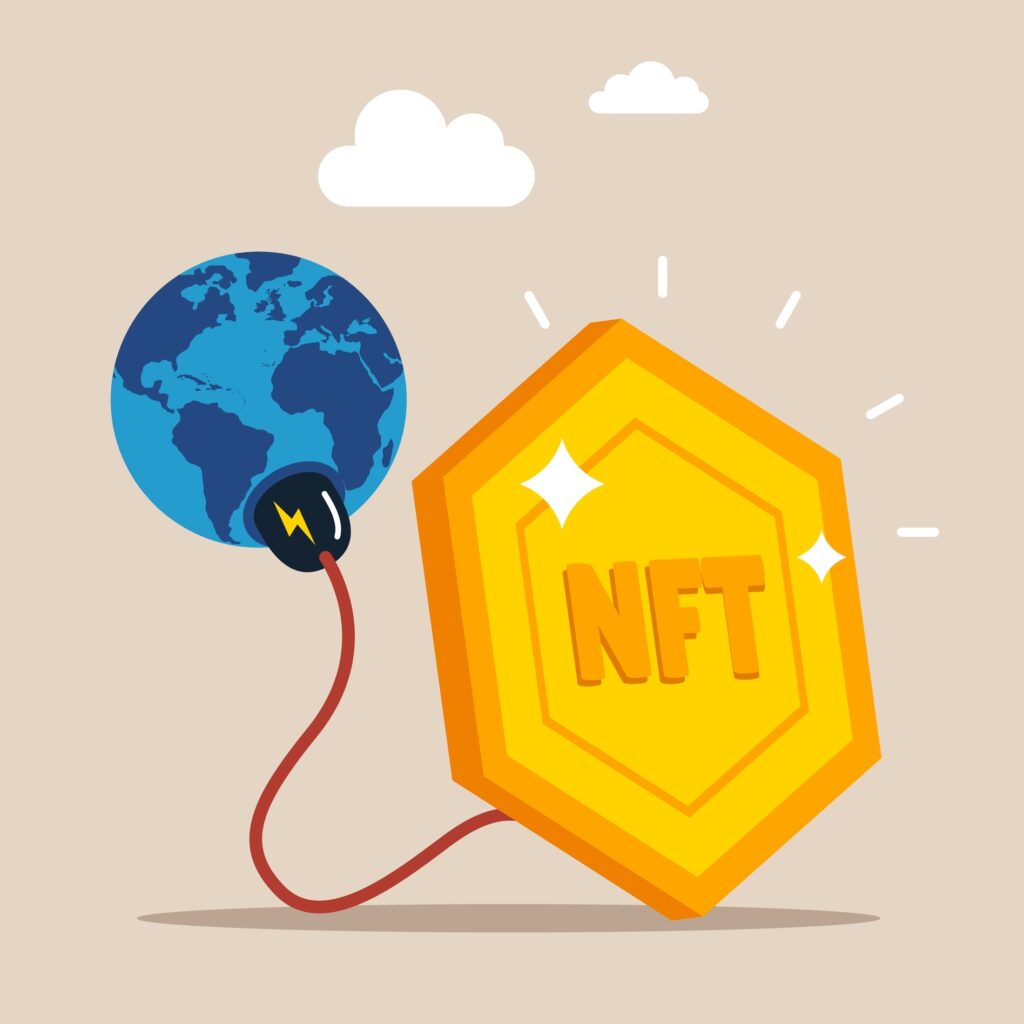The Future of NFTs: Why They’re More Than Just Digital Art
Despite the hype culture and millions of failed projects, the future of NFTs still looks promising.
How?
As this technology continues to evolve, the potential applications and use cases of NFTs are far-reaching, presenting an exciting and rapidly developing landscape for exploration that can change everything. But there are limitations as well.
Let’s start from the beginning…
What are Non-Fungible Tokens (NFTs)?
NFTs, short for non-fungible tokens, are digital assets that utilize blockchain technology to verify ownership and authenticity. Unlike traditional cryptocurrencies, NFTs are unique in nature and can give value to digital assets like artwork, music, videos, and tweets.
Each NFT is assigned a unique token ID securely stored on the blockchain, a decentralized ledger that records ownership and transfers of the tokens. Another crucial element of NFTs and the DeFi ecosystem are smart contracts, automated digital agreements with predetermined terms.
NFTs revolutionized the way digital assets are traded and valued by tokenizing digital art and utilizing the security of blockchain technology.
The Peak of NFTs

2021 was when NFTs hit their peak in popularity. Artists, collectors, and investors all took notice and began exploring NFTs, resulting in the emergence of countless NFT projects. Some of the biggest names in the NFT game include CryptoPunks, Bored Ape Society, and Degods.
One of many particularly noteworthy achievements in 2021 was the sale of digital artwork by the Beeple for a whopping $69 million at auction, making it one of the most expensive digital artworks ever sold. Even Jack Dorsey, the co-founder of Twitter, got in on the action, selling a tweet for over $2.9 million.
Then there were people who made thousands and millions of dollars flipping NFTs.
Pop culture and mainstream media also hopped on the NFT bandwagon, sparking a lot of buzz and inspiring artists, musicians, and athletes to explore monetizing their talents through NFTs. For instance, Nas sold the royalty rights for two of his songs as NFTs. Another example is the NBA launching its Top Shot platform.
It’s clear that the peak of NFTs in 2021 marked an important moment in the evolution of art and digital assets. But it didn’t last long.
Are NFTs Dead?
NFTs experienced exponential growth in 2021. But things took a nosedive in 2022, leading some to wonder if NFTs were just a fad. One of the biggest reasons for this drop was the bear market and weak economic conditions worldwide.
At the peak of NFTs, people invested in projects based on hype and FOMO instead of actually evaluating their utility and use cases. So, when the bear market hit, these projects were the first to crash.
We must understand that the NFT hype culture and the underlying tech are two very different things. Even now, when the buzz has quieted down, the technology is still super innovative.
So, to wrap it up, while the hype may have died down, the technology will keep growing and expanding in ways we can’t predict. It’s a game changer for industries across the board, which brings us to…
The Future Applications of NFTs
While digital art has been the most popular and well-known use case for non-fungible tokens (NFTs), its potential extends far beyond the realm of art.
In fact, NFTs have the capability to revolutionize many different sectors and industries, offering innovative solutions to a variety of problems. Some of which we’ll discuss in the following sections.
NFTs as Content?
The primary benefit of content as NFTs is that they enable content creators to directly monetize their work and retain more control over their intellectual property. This is a common problem, especially in the music industry, where artists feel that they are being exploited.
But now, instead of selling their work through third-party platforms, which often take a significant cut of the profits, creators can directly sell to their audience, cutting out the middleman and keeping more of their income for themselves.
Tory Lanez is a great example, who leveraged NFT technology early on by releasing a full album in NFT.
Another benefit is that the technology allows creators to enforce their intellectual property rights more easily. By creating a unique token for each piece of content, creators can ensure their work is not copied or distributed without permission. This can be particularly useful for artists and musicians, who are often the victim of piracy.
Furthermore, NFTs may also introduce new distribution strategies. For instance, creators can create limited-edition versions of their work or sell access to exclusive content without using paywall services.
By cutting out intermediaries and providing new ways to enforce intellectual property rights, NFTs help create a more equitable and sustainable content creation and distribution model.
The future of NFTs is closer than ever before. Expect to see more artwork, music, videos and even movies in NFTs.
NFTs as a Mode of Transaction?
By utilizing NFTs, businesses can create a more secure, transparent, and efficient system for managing transactions and subscriptions.
NFTs’ ability to create unique, non-fungible digital assets can be particularly valuable for subscription-based businesses, like Netflix, where businesses can use NFTs to create unique subscription plans and reward loyal customers with special perks and privileges.
It can also make it easier to track and manage purchase data.
Plus, a decentralized ledger can ensure that transaction records are immutable and tamper-proof, making it more difficult for fraud and other types of financial crimes to occur.
For example, imagine someone is selling you a used car claiming it’s new. With blockchain, you can see how many times it has been purchased and sold before you.
However, scalability can be an issue in using NFTs as a mode of transaction.
NFTs as Documentation?
By using NFTs for documentation, we can create a unique and tamper-proof record of ownership. This can be a game changer for many industries.
For instance, in the healthcare industry, where patient records are sensitive and confidential, it can help protect them from unauthorized access or alteration.
Using NFTs, we can also create a secure and immutable record of an individual’s identity and education credentials, reducing fraud and making it easier for employers, educational institutions, and other organizations to verify the authenticity of an individual’s credentials.
Overall, the future of NFTs as documentation represents a significant opportunity to create a more secure, transparent, and efficient system for managing and sharing important information.
Branding and Marketing with NFTs?
NFTs are transforming how businesses market and brand themselves.
By tokenizing assets, companies can create unique and meaningful experiences that set them apart from their competitors and build stronger connections with their customers.
For instance, Dolce and Gabbana have seen success with their NFT collection, and Adidas has recently entered Web3 and is using NFTs to promote its products while also creating its own NFTs.
NFTs in and as Games?
NFTs as in-game items has opened up a world of customization and personalization. In games such as Axie Infinity and Splinterlands, NFTs have become highly sought-after commodities, with individual sales reaching hundreds of thousands of dollars.
In addition to in-game items, NFTs have become an integral part of the gaming experience itself.
Decentraland, for instance, allows players to build and own virtual real estate within a virtual world, and NFTs serve as proof of ownership to verify these transactions.
This creates an immersive gaming experience where players can interact with others, attend events, and even develop their own games within the game. However, Decentraland has become more of a metaverse platform than a game now.
The Sandbox and F1 Delta Time, which has now shut down, are other great examples of games that took this concept further, allowing players to design and own their race cars and tracks and sell them on NFT marketplaces like OpenSea.
Check out our list of best play-to-earn crypto games for more such innovative gaming models.
To summarize, NFTs have introduced a different level of innovation and excitement to the gaming industry, which will propel it to continue to rise and expand.
Factors Stopping the Adoption NFTs
The first and probably the biggest factor stopping the adoption of NFTs is their high energy consumption for processing transactions. As a result, the environment is negatively affected due to its reliance on non-renewable energy sources.

However, lately, more energy-efficient blockchains, such as Solana and Avalanche, some of the top cryptocurrencies in 2023, are becoming increasingly popular. They are known for their low energy consumption and fast transaction times, making them more eco-friendly and efficient compared to Ethereum.
Even Ethereum has taken steps to reduce its negative impact on the environment by reducing its energy consumption by 99.98%,
The second factor is Interoperability, as NFTs built on different blockchains are not compatible with each other. It limits the ability of NFT owners to use their assets across different platforms.
However, we already have solutions like wrapped tokens and cross-bridges, though they are highly vulnerable to hacks. But they only work on cryptocurrencies for now. However, it’s not unrealistic to expect some similar solutions for NFTs soon.
But till then, NFTs still have a long way to go. The complete adoption of NFTs in different sectors and industries we discussed will only occur after we solve these problems.
The Future of NFTs – Promising or Doomed?
Several factors have hindered the adoption and future of NFT, such as the lack of understanding and awareness, the cost of entry, an uncertain legal environment, and problems of scams and fraud.
However, we need to remind ourselves that crypto and NFTs are still in their nascent stages. With the rapid exponential growth and innovation we have seen in this short period, it’s not hard to imagine a future where these problems no longer exist. From where we stand, the future of NFTs seems promising.